
Guido Reni, a prominent Italian Baroque painter, was born in 1575 in Bologna and active until his death in 1642. Renowned for his elegant and emotionally charged works, he became a leading figure in the Bolognese School, blending classical ideals with a unique, refined style. His art often explored religious themes, capturing dramatic intensity and serene beauty, making him one of the most celebrated artists of his time, with works like Archangel Michael Defeating Satan showcasing his mastery.
1.1. Brief Biography of Guido Reni
Guido Reni, born in 1575 in Bologna, Italy, was a prominent Baroque painter and a key figure in the Bolognese School. He trained under Denys Calvaert and later joined the Carracci Academy, refining his skills. Reni’s work blended classical elegance with emotional depth, earning him acclaim across Europe. He was particularly known for his religious paintings, including Archangel Michael Defeating Satan, created in 1635. Reni’s career spanned over four decades, leaving a lasting legacy in Baroque art. His harmonious compositions and masterful use of light and color solidified his reputation as one of the 17th century’s most gifted artists.
1.2. Reni’s Contribution to Baroque Art
Guido Reni significantly influenced the development of Baroque art, bringing a unique elegance and emotional intensity to his works. Unlike the dramatic chiaroscuro of Caravaggio, Reni’s style emphasized harmonious compositions and refined grace, creating a serene yet powerful visual language. His use of light and shadow, combined with vivid color palettes, set a new standard for Baroque painting. Works like Archangel Michael Defeating Satan exemplified his ability to blend classical ideals with dynamic movement, inspiring countless artists and establishing him as a central figure in the Bolognese School. His contributions remain pivotal in the evolution of Baroque art.
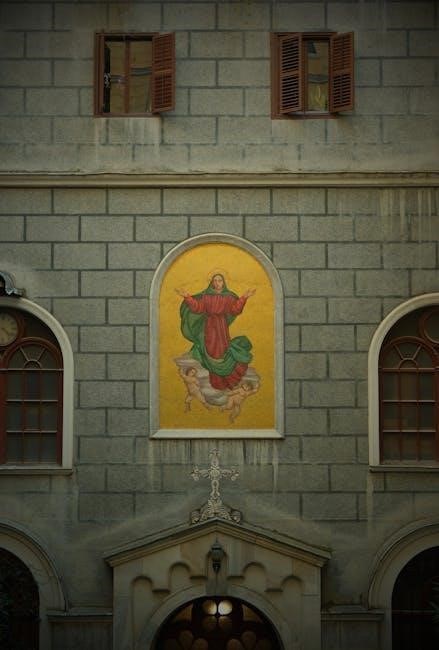
The Painting “Archangel Michael Defeating Satan”
Archangel Michael Defeating Satan, painted by Guido Reni in 1635, is a Baroque masterpiece depicting the triumph of good over evil. Housed in Santa Maria della Concezione, Rome, it captures the divine struggle with dramatic intensity and religious symbolism, embodying the era’s spiritual themes.
2.1. Historical Background of the Painting
Archangel Michael Defeating Satan was created by Guido Reni in 1635 during the Baroque period. Commissioned by Cardinal Sant’Onofrio, the painting reflects the Catholic Church’s influence in 17th-century Italy. It was intended for the church of Santa Maria della Concezione dei Cappuccini in Rome, where it remains a significant artifact. The work embodies the spiritual themes prevalent during the Counter-Reformation, emphasizing the triumph of good over evil. Reni’s masterpiece is celebrated for its dramatic composition and emotional depth, making it a cornerstone of Baroque religious art and a testament to the era’s cultural and theological climate.
2.2. The Story Behind the Artwork
Guido Reni’s Archangel Michael Defeating Satan captures the iconic biblical battle between good and evil. Painted in 1635, the artwork depicts Michael, clad in a Roman military cloak and cuirass, triumphantly overpowering Satan. The scene is charged with emotional intensity, illustrating the divine struggle between light and darkness. Reni’s dynamic composition and use of dramatic lighting emphasize the celestial conflict, embodying the spiritual themes of the Counter-Reformation. The painting serves as a powerful visual narrative, reinforcing the Catholic Church’s message of good’s ultimate victory over evil, resonating deeply with the religious fervor of 17th-century Italy.
2.3. The Role of Cardinal Sant’Onofrio
Cardinal Sant’Onofrio played a pivotal role in commissioning Guido Reni’s Archangel Michael Defeating Satan, completed in 1635. As a prominent figure in the Catholic Church, the cardinal sought to emphasize the triumph of good over evil, aligning with the Counter-Reformation ideals. Reni’s masterpiece was created specifically for the Church of Santa Maria della Concezione dei Cappuccini in Rome, where the cardinal held significant influence. The painting’s placement in this sacred space underscored its religious significance, serving as a visual testament to the divine struggle and reinforcing the cardinal’s devotion to the Church’s doctrines. His patronage was instrumental in bringing Reni’s vision to life.
Artistic Style and Technique
Guido Reni’s artistic style in Archangel Michael Defeating Satan reflects elegance and dynamic composition, blending natural light and harmonious colors to create a dramatic yet serene atmosphere.
3.1. Baroque Elements in the Painting
Guido Reni’s Archangel Michael Defeating Satan exemplifies Baroque art through its dramatic lighting, intense emotions, and dynamic movement. The painting features strong contrasts of light and shadow, a hallmark of the Baroque style, creating a vivid, three-dimensional effect. Reni’s use of chiaroscuro emphasizes the struggle between good and evil, drawing the viewer’s eye to the central conflict. The composition’s balance and harmonious arrangement of figures reflect Reni’s adaptation of Baroque elements to his own refined aesthetic, blending dramatic intensity with classical grace. This approach highlights the emotional and spiritual depth of the scene, typical of Baroque art’s focus on storytelling and religious themes.
3.2. Use of Light and Shadow
Guido Reni’s masterful use of light and shadow in Archangel Michael Defeating Satan creates a dramatic and emotionally charged atmosphere. The strong contrast of chiaroscuro highlights Michael’s radiant face and shimmering armor, symbolizing divine purity and strength. In contrast, Satan is shrouded in dark shadows, emphasizing his malevolent nature. The interplay of light and darkness not only enhances the painting’s depth but also focuses the viewer’s attention on the central struggle between good and evil. This technique, characteristic of the Baroque style, adds emotional intensity and underscores the spiritual significance of the scene. Reni’s use of light and shadow is both technically brilliant and deeply expressive.
3.3. Composition and Perspective
In Archangel Michael Defeating Satan, Guido Reni employs a dynamic composition to convey the epic struggle between good and evil. The painting’s central diagonal line, descending from heaven to earth, creates a sense of movement and energy. Michael’s pose, with his sword raised high, dominates the scene, while Satan’s twisted form adds tension. Reni’s use of perspective draws the viewer’s eye upward, emphasizing Michael’s divine authority. The balanced structure and harmonious lines create a sense of order, contrasting with the chaos of the battle. This composition masterfully captures both drama and serenity, reflecting Reni’s technical skill and artistic vision.
Symbolism in the Painting
The painting is rich in symbolism, with Archangel Michael representing divine justice and purity, while Satan embodies evil and chaos. The sword and shield symbolize protection and righteousness, while the serpent represents temptation and sin, reinforcing the universal struggle between light and darkness.

4.1. Archangel Michael as a Symbol of Good
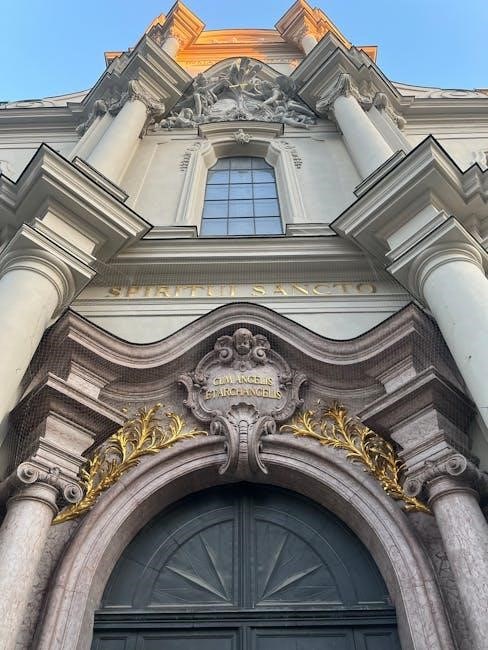
Archangel Michael is depicted as a powerful symbol of good, embodying divine justice and purity. Clad in a Roman military cloak and cuirass, he exudes strength and authority. His serene expression reflects divine calm, contrasting the chaos of evil. The sword in his hand symbolizes righteousness and judgment, while his shield bears the cross, a potent emblem of faith. As a celestial warrior, Michael represents the triumph of light over darkness, embodying hope and divine intervention. His portrayal in the painting reinforces the Baroque theme of moral clarity, making him a timeless icon of goodness and redemption.
4;2. Satan as a Representation of Evil
Satan, depicted as a serpent-like figure, embodies evil and chaos. His twisted form and dark presence contrast sharply with Michael’s radiance, symbolizing the corrupt and malevolent forces of the world. The serpent, a classic symbol of temptation and sin, reinforces Satan’s role as the embodiment of evil. His defeat by Michael signifies the triumph of divine order over darkness, aligning with the painting’s religious themes. Satan’s portrayal serves as a visual reminder of the eternal struggle between good and evil, emphasizing the moral clarity central to Baroque art and Reni’s interpretation of celestial conflict.
4.3. Religious and Spiritual Themes
Guido Reni’s Archangel Michael Defeating Satan is deeply rooted in religious symbolism, depicting the celestial battle between good and evil. The painting embodies the Catholic Church’s teachings, emphasizing divine justice and redemption. Michael, as God’s protector, represents the triumph of faith, while Satan, depicted as a serpent, symbolizes sin and corruption. The artwork reflects the spiritual values of the 17th century, inspiring awe and reflection. It serves as a visual testament to the eternal struggle between light and darkness, reinforcing the belief in divine intervention and the ultimate victory of righteousness over evil.
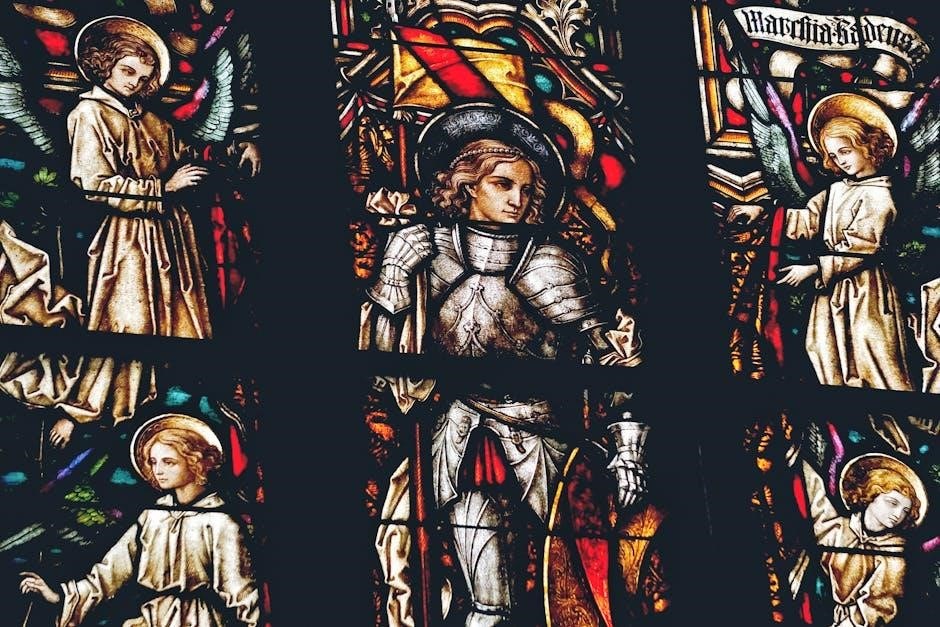
The Depiction of Archangel Michael
Archangel Michael is portrayed as a divine warrior, wearing a Roman military cloak and cuirass, symbolizing strength and authority. His depiction trampling Satan emphasizes his triumph over evil, embodying divine justice and power.
5.1. Michael’s Armor and Attire
Archangel Michael is depicted wearing a Roman military cloak and cuirass, symbolizing his divine authority and strength. The armor is intricately detailed, evoking classical ideals of heroism, while the flowing cloak adds a sense of drama and divine presence. Reni’s depiction reflects the Baroque emphasis on dramatic flair, with the attire emphasizing Michael’s role as a celestial warrior. The choice of Roman military garb connects the archangel to timeless ideals of justice and protection, while the pristine white and gold hues underscore his purity and divine mission. This attire not only highlights Michael’s power but also aligns with Reni’s refined and classical artistic style.
5.2. The Sword and Shield as Symbols
Guido Reni’s depiction of Archangel Michael features a gleaming sword and shield, potent symbols of divine justice and protection. The sword, raised triumphantly, signifies the power to vanquish evil, while the shield, often adorned with celestial motifs, represents defense of the faithful. These elements emphasize Michael’s dual role as a warrior and guardian. The sword’s light reflects divine illumination, while the shield’s intricate design underscores heavenly protection. Together, they embody the eternal struggle between good and evil, reinforcing the painting’s central theme of triumph and redemption through divine intervention. These symbols are rendered with meticulous detail, enhancing the artwork’s spiritual depth.
5.3. Facial Expression and Emotion
Archangel Michael’s facial expression in Guido Reni’s painting exudes calm determination and divine resolve. His serene gaze contrasts with the turmoil of the defeated Satan, emphasizing the triumph of good over evil. The subtle tension in his features reflects the gravity of the cosmic battle while maintaining a sense of celestial tranquility. This emotional balance underscores Michael’s role as a protector and enforcer of divine justice, embodying both strength and compassion. The artist’s mastery in capturing these nuances enhances the painting’s spiritual depth and emotional impact, inviting viewers to reflect on the eternal struggle between light and darkness. Reni’s portrayal remains deeply evocative.
The Portrayal of Satan
Satan is depicted in a dramatic, disheveled state, emphasizing his defeat and evil nature. His twisted form and serpent-like features symbolize chaos and corruption, contrasting sharply with Michael’s divine grace and order. The emotional intensity of Satan’s expression reflects his torment and defiance, while his posture conveys submission to divine authority. Reni’s portrayal captures the essence of evil’s struggle against righteousness, adding depth to the painting’s narrative and reinforcing its spiritual themes. The depiction underscores the cosmic conflict, making Satan a compelling yet reviled figure in the composition;

6.1. Physical Appearance of Satan
Satan is depicted as a monstrous, disheveled figure, with twisted features and a serpent-like form. His body is contorted, emphasizing his suffering and defeat. The dark, shadowy tones and exaggerated facial expressions highlight his evil nature. Reni’s portrayal captures the essence of chaos and corruption, with Satan’s appearance contrasting sharply with Michael’s divine elegance. The physical deformation and grotesque details, such as bat-like wings and scaled skin, reinforce the notion of evil’s ugliness. This depiction underscores the struggle between light and darkness, making Satan a visually compelling yet repulsive figure in the composition.
6.2. Symbolism of Satan’s Defeat
Satan’s defeat symbolizes the triumph of divine order over chaos and evil. Reni’s depiction emphasizes moral victory, with Satan’s fall representing sin’s conquest by righteousness. The dark, twisted figure of Satan, often portrayed with serpentine features, embodies corruption and disorder. His defeat underscores the Church’s teachings on redemption and the eternal struggle between good and evil. The painting serves as a visual sermon, reinforcing Catholic doctrine and the belief in divine justice. Satan’s humiliation also reflects the Counter-Reformation’s emphasis on faith’s power over heresy and moral decay, aligning with the era’s religious and cultural values.
6.3. The Serpent as a Symbol of Temptation
The serpent in Reni’s painting embodies temptation and sin, drawing from biblical narratives like the Fall of Man. Its twisted form symbolizes deceit and corruption, linking Satan to the original sin in Eden. The serpent’s presence underscores the broader theme of temptation and humanity’s vulnerability to evil. By depicting Satan with serpentine features, Reni visually connects the devil to the source of human downfall, reinforcing the painting’s moral message. This imagery aligns with Catholic teachings, emphasizing the necessity of divine intervention and the triumph of good over evil, central to the artwork’s religious and symbolic intent.

Cultural and Historical Context
Created in 1635 for Cardinal Sant’Onofrio, Reni’s masterpiece reflects the Catholic Church’s influence during the Baroque era, blending religious themes with dramatic intensity to inspire devotion and contemplation.
7.1. The Painting’s Reception in the 17th Century
Guido Reni’s Archangel Michael Defeating Satan was widely acclaimed in the 17th century for its dramatic composition and emotional depth. The painting, created in 1635, resonated with the religious fervor of the time, as the Catholic Church emphasized the struggle between good and evil. Its vivid use of light and shadow, characteristic of Baroque art, captivated audiences and solidified Reni’s reputation as a master painter. The work was praised for its ability to evoke powerful emotions, aligning with the era’s artistic and spiritual values. It quickly became a model for other artists, further cementing its cultural significance.
7.2. Influence of the Catholic Church
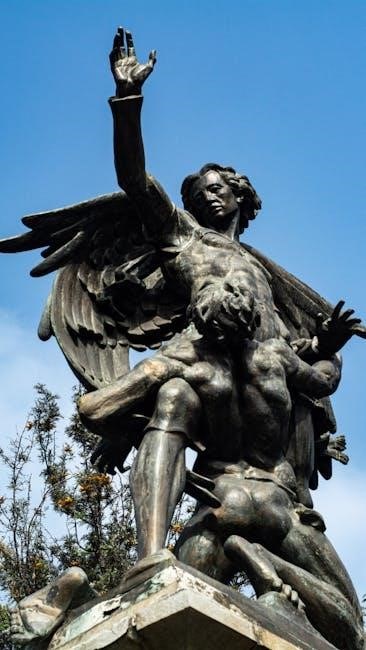
The Catholic Church played a pivotal role in commissioning and promoting Guido Reni’s Archangel Michael Defeating Satan. Cardinal Sant’Onofrio, a high-ranking official, specifically requested the painting to adorn the Chiesa di Santa Maria della Concezione dei Cappuccini in Rome. The Church’s emphasis on religious art as a tool for spiritual instruction aligned perfectly with Reni’s work. The painting’s depiction of Michael triumphing over Satan symbolized the Church’s doctrine of good overcoming evil, reinforcing its message to the faithful. This collaboration not only elevated the painting’s status but also underscored the Church’s influence in shaping Baroque art and spirituality during the 17th century.
7.3. The Painting’s Place in Baroque Art History
Guido Reni’s Archangel Michael Defeating Satan stands as a landmark in Baroque art, exemplifying the period’s dramatic intensity and emotional depth. Reni’s mastery of chiaroscuro and dynamic composition elevated the painting to a quintessential Baroque work. Its balanced elegance and spiritual themes resonated with the era’s artistic and religious sensibilities. The painting’s widespread admiration and reproduction solidified Reni’s reputation as a leading figure in the Bolognese School. It remains a testament to the Baroque’s ability to convey profound narratives through art, ensuring its enduring influence in the history of European painting.

The Painting’s Legacy
Guido Reni’s Archangel Michael Defeating Satan is celebrated as a Baroque masterpiece, inspiring countless reproductions and influencing later artists with its dramatic style and emotional depth.
8;1. Copies and Reproductions
Guido Reni’s Archangel Michael Defeating Satan has inspired numerous reproductions, including museum-quality oil painting copies and high-resolution prints. These works are meticulously hand-painted on canvas, capturing the original’s vibrant colors and intricate details; Available as wall art, they are popular for home decor, offering a glimpse into Baroque mastery. Additionally, engravings and digital reproductions have made the artwork accessible globally, ensuring its timeless appeal endures across generations and mediums.
8.2. Modern Interpretations and Relevance
Guido Reni’s Archangel Michael Defeating Satan remains a powerful symbol of the eternal struggle between good and evil. Contemporary audiences interpret it as a timeless allegory, resonating with themes of light overcoming darkness. The painting’s emotional depth and dynamic composition continue to inspire artists and art lovers alike. Its universal message transcends centuries, maintaining its relevance in modern cultural and spiritual discussions. The artwork also sparks reflections on morality and the human condition, solidifying its place in the continuum of artistic expression and spiritual inspiration.
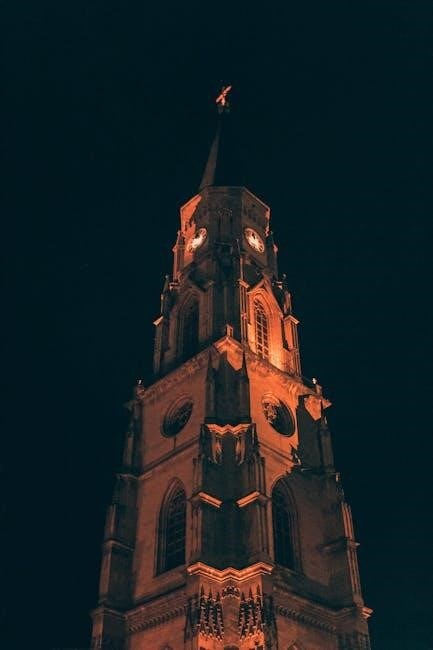
8.3. The Painting’s Influence on Other Artists
Guido Reni’s Archangel Michael Defeating Satan has profoundly influenced numerous artists, inspiring many to adopt its dynamic composition and emotional depth. The painting’s use of light and shadow, characteristic of Baroque art, has been particularly admired and emulated. Several artists have created reproductions or works inspired by this masterpiece, testament to its enduring appeal. Its influence extends beyond the Baroque period, with modern artists drawing from its themes of struggle and triumph. Reni’s work remains a vital source of inspiration, reflecting its timeless artistic and emotional resonance.
Guido Reni’s Archangel Michael Defeating Satan stands as a masterpiece of Baroque art, symbolizing the eternal conflict between good and evil. Its intricate details and emotional depth continue to captivate audiences, solidifying its place in art history as a profound representation of faith and struggle.
9.1. Summary of Key Points
Guido Reni’s Archangel Michael Defeating Satan is a seminal work of Baroque art, created in 1635 for Cardinal Sant’Onofrio. It captures the epic struggle between good and evil, with Michael, clad in Roman armor, triumphing over Satan, depicted as a serpent-like figure. The painting’s dramatic lighting, dynamic composition, and emotional intensity exemplify Reni’s mastery of Baroque techniques. Its religious and symbolic themes resonate deeply, reflecting the Catholic Church’s influence during the 17th century. The artwork remains a cornerstone of art history, inspiring copies and reproductions while continuing to captivate modern audiences with its timeless narrative.
9.2. Final Thoughts on the Painting’s Significance
Guido Reni’s Archangel Michael Defeating Satan stands as a masterpiece of Baroque art, encapsulating the eternal struggle between good and evil. Its powerful depiction of Michael’s triumph, combined with Reni’s mastery of light, shadow, and composition, creates a visually and emotionally compelling work. The painting not only reflects the religious and cultural values of 17th-century Italy but also continues to inspire awe and reflection today. Its enduring relevance lies in its universal themes of hope, justice, and the triumph of light over darkness, ensuring its place as a timeless icon in art history.